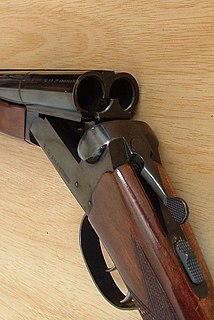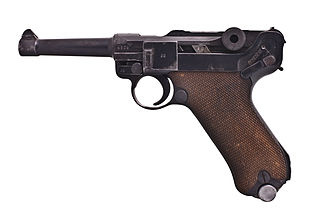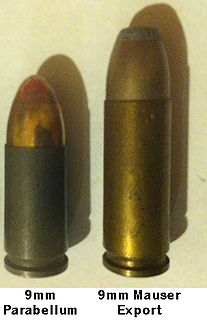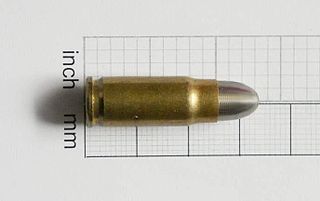
In firearms terminology, an action is the functional mechanism of a breech-loading firearm that handles the ammunition cartridges, or the method by which that mechanism works. Actions are technically not present on muzzleloaders, as all those are single-shot firearms with a closed off breech with the powder and projectile manually loaded from the muzzle. Instead, the muzzleloader ignition mechanism is referred to as the lock.

The Pistole Parabellum—or Parabellum-Pistole, commonly known as just Luger or Luger P08 is a toggle-locked recoil-operated semi-automatic pistol. The Luger was produced in several models and by several nations from 1898 to 1949.

The Mauser C96 is a semi-automatic pistol that was originally produced by German arms manufacturer Mauser from 1896 to 1937. Unlicensed copies of the gun were also manufactured in Spain and China in the first half of the 20th century.

The Military Armament Corporation Model 10, officially abbreviated as "M10" or "M-10", and more commonly known as the MAC-10, is a compact, blowback operated machine pistol/submachine gun that was developed by Gordon B. Ingram in 1964. It is chambered in either .45 ACP or 9mm. A two-stage suppressor by Sionics was designed for the MAC-10, which not only abates the noise created, but makes it easier to control on full automatic. For a decade, the semi-automatic pistol version of the weapon was forbidden in the U.S. under the assault weapons ban enacted by Congress in 1994.

The 7.62×25mm Tokarev cartridge is a Russian rimless bottlenecked pistol cartridge widely used in former Soviet states and in China, among other countries. The cartridge has since been replaced in most capacities by the 9×18mm Makarov in Russian service.

The TT-30, commonly known simply as the Tokarev, is an out-of-production Soviet semi-automatic pistol. It was developed in 1930 by Fedor Tokarev as a service pistol for the Soviet military to replace the Nagant M1895 revolver that had been in use since the Russian Empire, though it ended up being used in conjunction with, rather than replacing, the M1895. It served until 1952, when it was replaced by the Makarov pistol.

The Nambu pistols are a series of semi-automatic pistols produced by the Japanese company Koishikawa Arsenal, later known as the Tokyo Artillery Arsenal. The series has three variants, the Type A, the Type B, and the Type 14 (南部十四年式自動拳銃). The Nambu pistols were designed to replace Japan's earlier service pistol, the Type 26 revolver.

The MP 18, manufactured by Theodor Bergmann Abteilung Waffenbau, was arguably the first submachine gun used in combat. It was introduced into service in 1918 by the German Army during World War I as the primary weapon of the Sturmtruppen, assault groups specialized in trench combat. Although MP 18 production ended in the 1920s, its design formed the basis of most submachine guns manufactured between 1920 and 1960.
A Federal Firearms License (FFL) is a license in the United States that enables an individual or a company to engage in a business pertaining to the manufacture or importation of firearms and ammunition, or the interstate and intrastate sale of firearms. Holding an FFL to engage in certain such activities has been a legal requirement within the United States since the enactment of the Gun Control Act of 1968. The FFL is issued by the Bureau of Alcohol, Tobacco, Firearms, and Explosives

Hanyang Arsenal was one of the largest and oldest modern arsenals in Chinese history.

A service pistol, also known as a personal weapon or an ordnance weapon, is any handgun issued to regular military personnel or law enforcement officers. Typically, service pistols are revolvers or semi-automatic pistols issued to officers, non-commissioned officers, and rear-echelon support personnel for self-defense, though service pistols may also be issued to special forces as a backup for their primary weapons. Pistols are not typically issued to front-line infantry. Before firearms were commonplace, officers and non-commissioned officers typically carried swords instead.

An antique firearm is a term to describe a firearm that was designed and manufactured prior to the beginning of the 20th century. Although the exact definition of what constitutes an "antique firearm" varies between countries, the advent of smokeless powder or the start of the Boer War are often used as cut-off dates. Antique firearms are usually collected because of their historical interest and/or their monetary value.

The Astra Model 900 is one of many Spanish copies of the German Mauser C96 semi-automatic pistol. It shares the same caliber, magazine capacity, and holster type and is generally very similar to the German handgun.

The 9×25mm Mauser is a cartridge developed for the Mauser C96 service pistol around 1904 by DWM. Mauser pistols in this relatively powerful caliber were primarily intended for export to Africa, Asia, and South America. The 9mm Mauser Export cartridge was produced specifically for Mauser pistols and carbines made from 1904 to 1914 and then later from approximately 1930 to 1945 for submachine guns chambered for this caliber.

The 7.63×25mm Mauser round was the original cartridge for the Mauser C96 service pistol. This cartridge headspaces on the shoulder of the case. It later served as the basis for the 7.62mm Tokarev cartridge commonly used in Soviet and Eastern Bloc weapons.
The Kel-Tec P50 is a FN 5.7×28mm semi-automatic pistol designed in the United States by Kel-Tec in 2021.
Jonathan Steven Ferguson is a British firearm historian and author who is currently the Keeper of Firearms and Artillery at the Royal Armouries Museum in Leeds, England. He is also a technical specialist with Armament Research Services, a consultancy firm.

Chassepot to FAMAS: French Military Rifles, 1866–2016 is a 2019 book by Ian McCollum about the history of French military rifles. Chassepot to FAMAS was funded through Kickstarter, and it was the first book by Headstamp Publishing, which McCollum co-founded with N.R. Jenzen-Jones of Armament Research Services and James Rupley. The photography for the book was provided by Rupley and the book was edited by Jenzen-Jones. Yann Carcaillon and Jonathan Ferguson are listed as contributors.
Larry Allen Vickers is a retired Delta Force soldier, firearms instructor, and author. He is the founder of Vickers Tactical, and co-founder of the International Pistol Defense Association and Firearms Training Association.















